How to Repair Bowed or Buckling Walls?
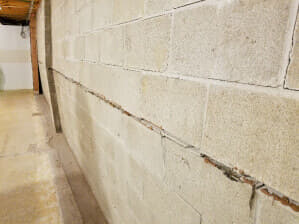
Originally posted 9/28/18, revised by Kelly Kater 8/13/20
If you have a basement wall that is bowing or buckling, please take action! Walls are not supposed to curve inward; this unnatural shape is a warning sign that your wall is moving and will ultimately collapse if not repaired.
Buckling walls don’t happen overnight; it’s a gradual process that happens over time. The first sign you have a problem is a long horizontal crack in the wall, or stair-stepping around the blocks. Once the cracks form, it’s easier for the existing weight and pressure to force the wall to bow.
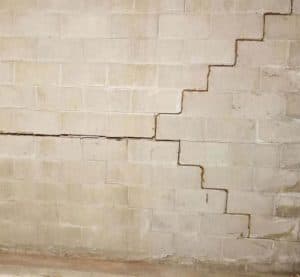 This photo was taken by an Acculevel project manager during a free estimate appointment. The wall has both types of cracks: long horizontal and stair-step.
This photo was taken by an Acculevel project manager during a free estimate appointment. The wall has both types of cracks: long horizontal and stair-step.
Buckling is the large red flag, warning you that the wall is failing. Obviously, you want to repair this damage promptly. But you also should assess what caused the problem and correct it, so it doesn’t happen again. This may include regrading your landscape, extending downspouts, or installing water drainage in your basement.
Acculevel is a foundation repair company, and we have perfected several methods of wall reinforcement that can restore strength and stability to your home. We’ve been helping people preserve their homes since 1996, serving Indiana and the surrounding states of Illinois, Michigan, Ohio, and Kentucky.
In this blog, we’ll start by exploring what forces can move a concrete foundation wall. We’ll then review the different repair options available, so you can determine which method is the best choice for you and your home.
What Makes a Wall Buckle?
Lateral Pressure
Take a moment, and remember the last time you planted something. A small bag of potting soil isn’t all that heavy, right? Now think about how much soil is around your house: that does weigh a significant amount. And that weight is surrounding your basement, pushing at the walls.
Basement walls are designed to support your home, which exerts pressure from above. The soil around the foundation presses in from the sides. In the foundation industry, we refer to this as lateral pressure.
Hydrostatic Pressure
Let’s think about that bag of potting soil. What happens to it, if it’s left outside in the rain? It absorbs water and increases- both in size and weight. When you pick it up, the pressure you exert squeezes water out of the bag.
The soil around your house functions the same way. It absorbs rain and expands- until it pushes against something that holds firm: your foundation. This water-based lateral pressure is called hydrostatic pressure.
The combination of lateral and hydrostatic pressure? Highly problematic. Your foundation isn’t always going to be an immobile object. If your soil exerts enough pressure, your foundation can “give” a little bit and crack. And once there’s a weak spot, pressure will continue to win the battle.
In the past, the only way to fix a buckling wall was to replace it. Fortunately, there now are methods that don’t require invasive construction. Some of them don’t even need excavation- the walls can be repaired from inside your basement.
Repair Methods for Buckling Walls
Carbon Fiber Straps
If your wall has bowed or buckled less than 2 inches, carbon fiber straps are your best option. These are the fastest and easiest to install, requiring no excavation or exterior installation.
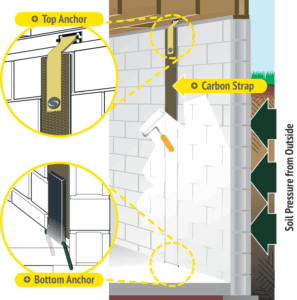 This is an illustration of how carbon fiber straps are installed.
This is an illustration of how carbon fiber straps are installed.
Carbon fiber straps are also the least expensive repair method. They are incredibly strong fibers woven together and adhered to your foundation with epoxy. If you’d like to know more details about straps and their costs, please check the resources provided at the end of this article.
Wall Anchors
If your wall has buckled more than 2 inches, you will need either anchors or tiebacks. The decided factor between these two methods is your property’s size and shape.
Wall anchors require excavation into your yard, usually about 10 feet past the damaged basement wall. If this doesn’t cross your property line, or intersect with something significant (inground pool, septic system, garage, porch, etc), anchors are a good option.
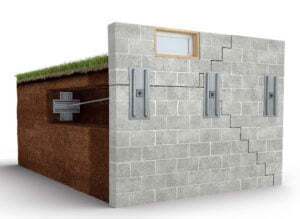 This is an illustration of how wall anchors are installed.
This is an illustration of how wall anchors are installed.
As you can see from the illustration, a large plate is buried in your yard- this is the anchor. A plate is attached to the damaged wall, and a post is drilled from the wall into the anchor. As it’s tightened, it pulls the wall plate and the wall securely together.
Helical Tie-backs
If your wall is buckling 2 inches or more, and exterior excavation for installing wall anchors isn’t a good fit, then your best option is tiebacks. Helical tiebacks are the most expensive option, but they don’t require excavation like anchors do. Tiebacks are installed from inside your basement, through the wall into the yard.
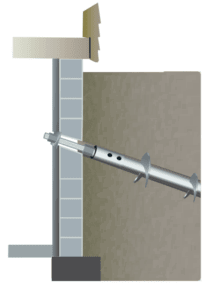 This is an illustration of how helical tiebacks are installed.
This is an illustration of how helical tiebacks are installed.
Somewhat similarly to anchors, a plate is attached to your basement wall. The steel tieback is driven through the wall and angled downward, deep into the ground. Once the tieback reaches the correct resistance (measured during install by hydraulic gauge), it’s secured to the wall plate to hold the wall in place.
Wall Straightening is a Different Repair Option
I want to emphasize that the goal with all three of these repair methods is to restore stability to your foundation. Acculevel guarantees that once your wall is repaired, it will not bow any further. If you want to straighten the basement wall and return it to its original position, this will require wall straightening.
Wall straightening is a different approach to repairing a buckling wall. It requires excavation, so the wall can be pushed back upright and help in place with jacks. Once the wall is fully upright, it will need to be secured with carbon fiber straps, wall anchors or tiebacks. Then, the excavated area can be filled back in with soil.
Additional Resources
If you would like more specific details about carbon fiber straps and how they work, we have a blog that focuses on this method exclusively.
Trying to budget for repairs? We break down the solution costs for buckling walls in this article.
Is water collecting around your foundation? We explain why everyone should extend downspouts at least 10 feet from a house in this DIY tutorial.
If your downspouts aren’t the issue, but you have water getting into your basement, it may be time to explore waterproofing. We review how this works- and what it costs- in this blog.
Do You Need a Buckling Wall Repaired?
You should find an experienced foundation company, and make an appointment. Before you sign a contract for any service, we urge you to always verify the company is reputable, insured, and accredited by the Better Business Bureau.
Not sure how to hire a contractor or the right questions to ask? Please use our Detailed Guide with Checklist. The article gives you some insight into why you should ask these questions and provides Acculevel’s answers. You can also download a blank checklist of the questions to fill out with any contractor you interview.
If you live in Indiana or the surrounding states, contact Acculevel. If you have noticed any problems and would like an evaluation, you can request a free estimate. An experienced project manager will examine the areas of concern and recommend the best course of action for you, to keep your home strong and healthy for years to come.
